High altitude tested homemade hot cross buns are soft, fluffy and subtly sweet, with raisins and warm spices. These make the perfect traditional roll to serve with Easter dinner.
You might also love these high altitude recipes for Parker house dinner rolls, potato rolls (Amish dinner rolls), and cheesy garlic herb bread rolls.

This site contains affiliate links. As an Amazon associate, I earn from qualifying purchases. This means that I may make a small commission if you purchase a product using those links. This in no way affects my opinion of those products and services. All opinions expressed on this site are my own.
What are Hot Cross Buns?
Hot cross buns are a type of soft and fluffy bread roll or dinner roll, traditionally made and eaten on Good Friday or Easter. They typically contain spices like cinnamon, allspice and nutmeg, as well as dried fruit, such as raisins, and are marked with a cross on top.
While some recipes will use a sweet powdered sugar icing to make the cross on top of the buns after they’ve baked, the traditional method is to use a paste made of flour and water to mark the buns before they’ve baked. The flour paste stays white, while the rest of the bun turns golden brown, making a pretty contrast in color.
Why You’ll Love This Recipe
Soft for Days. By using the tangzhong method for the yeast dough, a simple paste of flour, milk and water, the buns stay soft for days after baking, rather than becoming hard and stale.
Perfect for Easter Dinner. The flavors in these rolls are delicious with baked ham, potatoes, and all the other traditional items on your Easter dinner menu.
High Altitude Tested. While you can make these hot cross buns at any altitude, high altitude bakers can bake with confidence since I test all my recipes at Denver’s altitude of 5,280 feet. The main difference will be that the yeast dough will rise faster at high altitudes than it does at sea level.

See the recipe card at the end of the post for the full ingredients list and instructions.
Ingredients
Tangzhong
- The tangzhong starter is a simple mixture of water, milk and flour. Added to the dough, it keeps the buns soft and pillowy, and helps them rise higher and fluffier.
Dough
- Raisins. Instead of raisins, you could also use chopped dried apricots, or another dried fruit.
- Butter. Unsalted butter adds moisture, richness and flavor to the buns.
- Milk. Be sure to use whole milk for the best flavor and texture.
- Yeast. The yeast is the leavening agent which makes the buns rise.
- Sugar. Adds sweetness and helps to activate the yeast.
- Flour. For the best texture, use bread flour, not all-purpose flour.
- Spices. You’ll need salt, cinnamon, allspice and nutmeg to add flavor to the buns.
- Egg. Gives the dough structure, moisture and a richer flavor.
Egg Wash, Cross and Glaze
- An egg beaten with a little milk and brushed over the buns before baking makes them golden brown and shiny.
- The cross is made from a simple paste of flour and water.
- For a sweet, shiny finish, brush some warmed orange marmalade or apricot jam on top after baking the rolls.
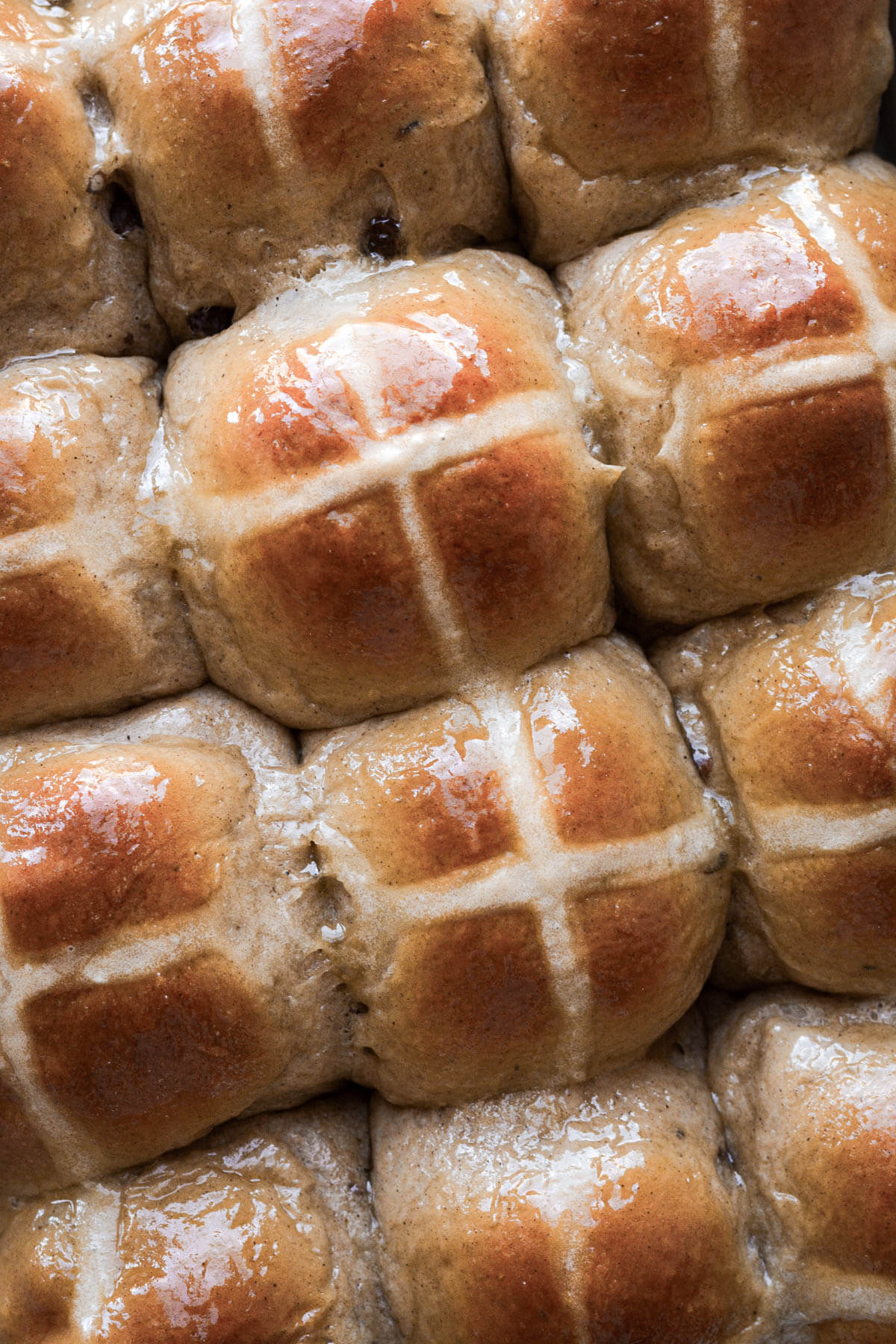

Instructions
Make the Tangzhong
- In a small saucepan, whisk together the water, milk and flour. Cook over medium heat for several minutes, whisking constantly, until it thickens into a paste.
- Remove from the heat, scrape the tangzhong into a small bowl, and refrigerate to cool it down while you make the dough.
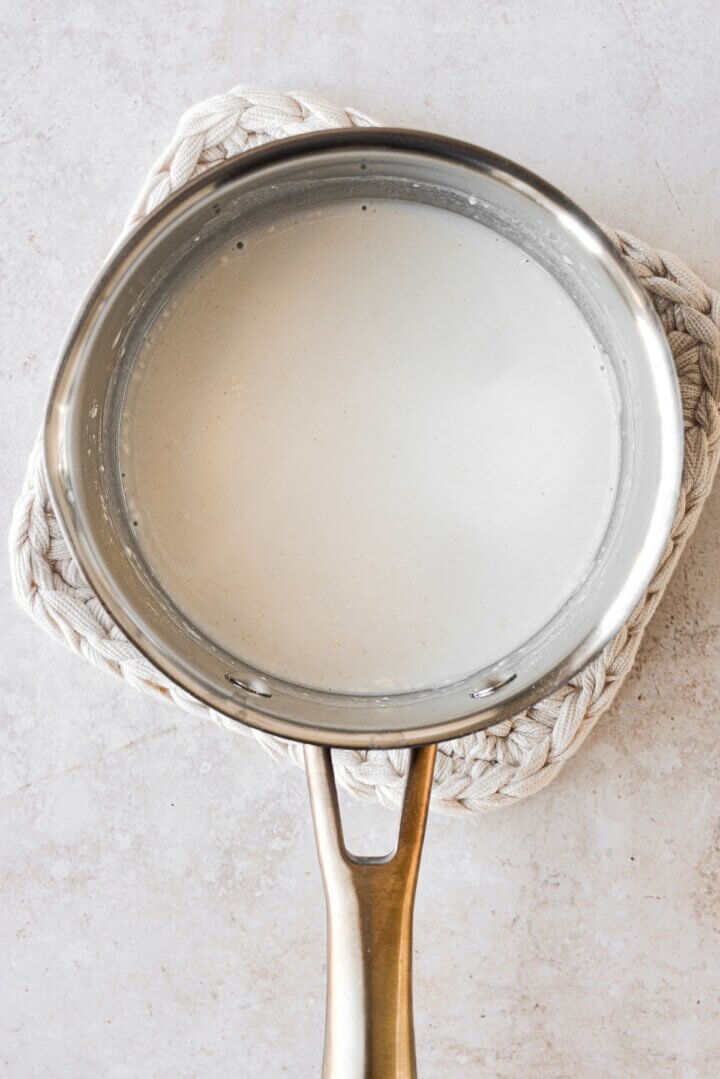
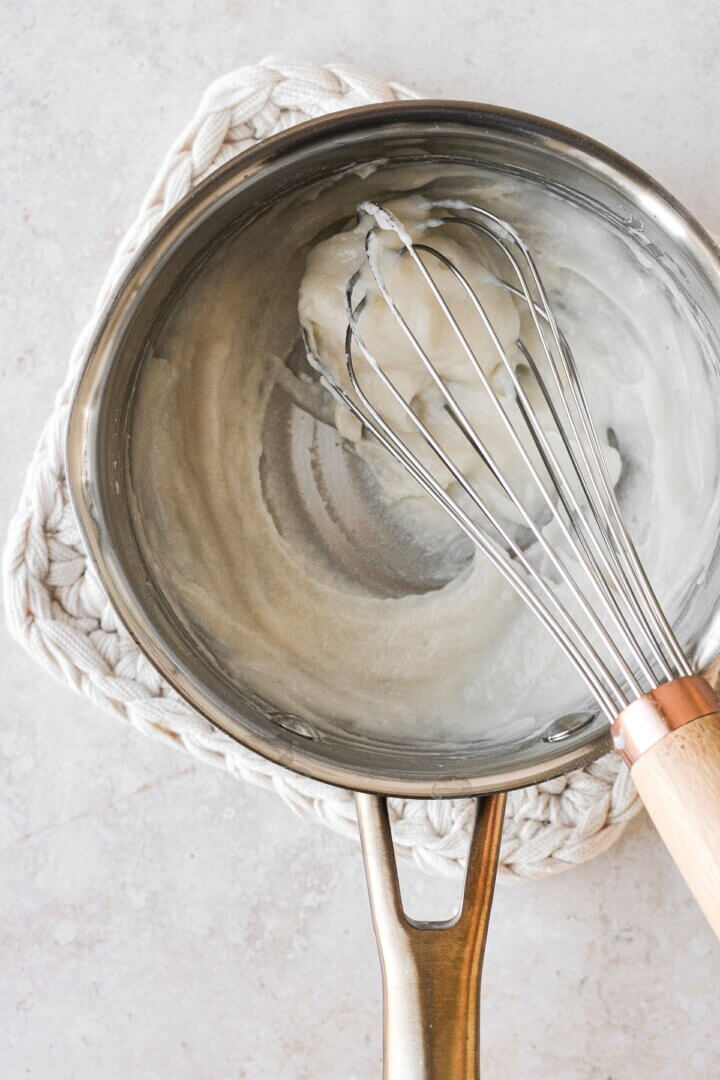
Make the Dough
- In a small bowl, combine the raisins with the hot water, then let them soak and soften for several minutes.
- In the same saucepan you used to make the tangzhong (no need to wash the pan first), melt the butter over medium heat. Stir in the milk, and warm the mixture just until it reaches between 110-115 degrees Fahrenheit.
- Remove from the heat. Stir in the yeast and 1 tablespoon of sugar. Let sit for a few minutes until it starts to get bubbly.
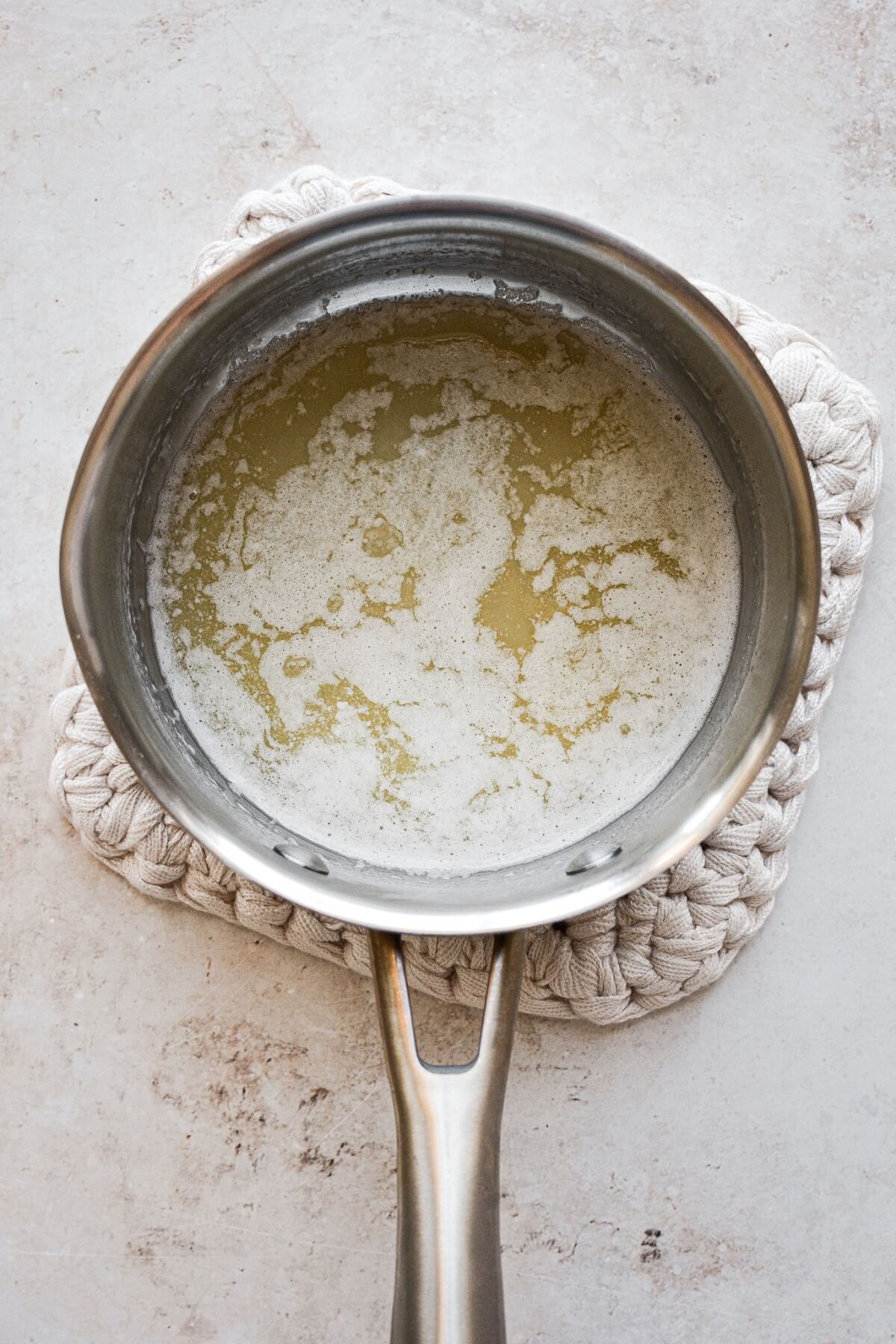
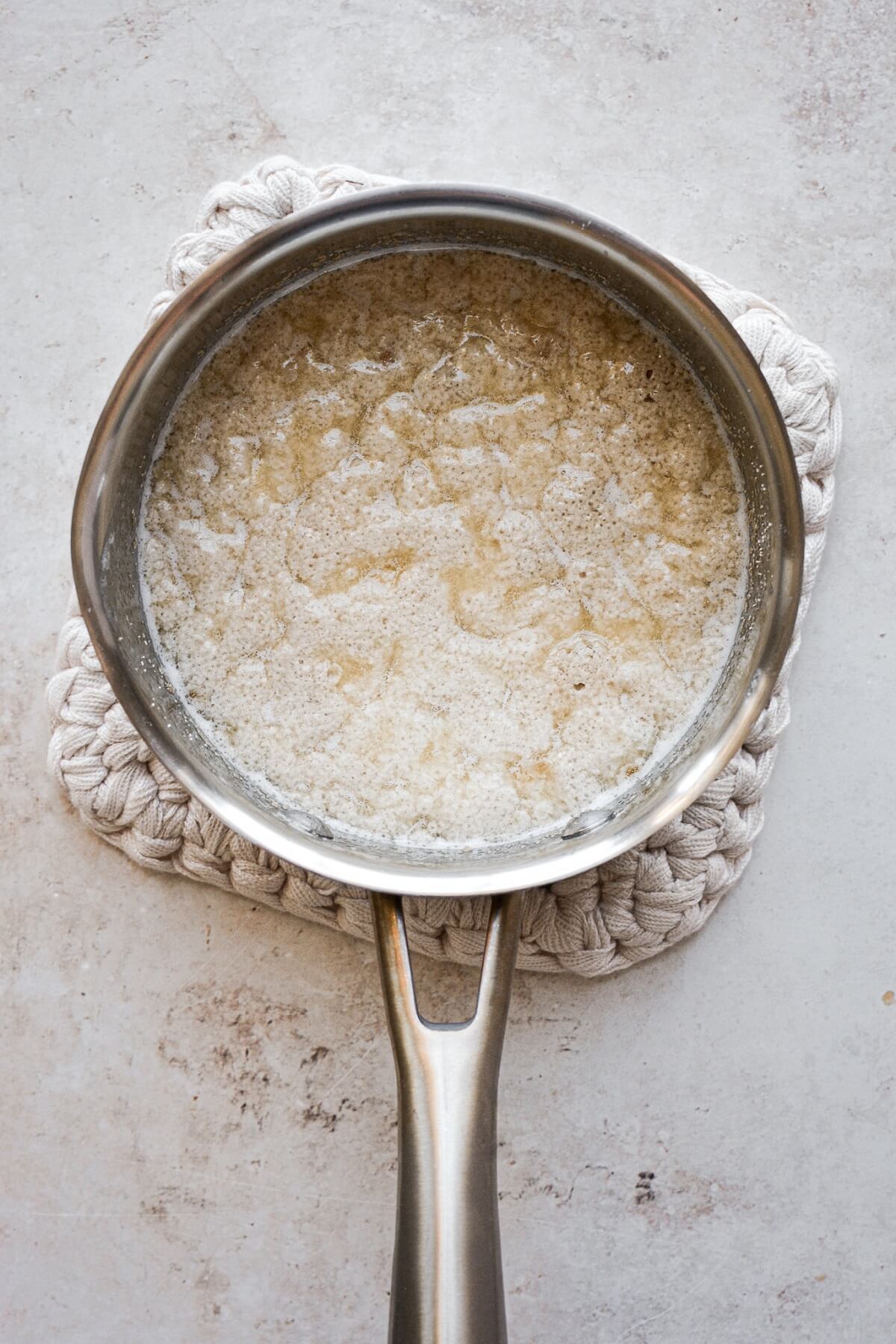
- In the bowl of your stand mixer, combine all but 1/2 cup of the flour with the remainder of the sugar, salt and spices. Add the warm yeast mixture, the cooled tangzhong, egg and raisins, including the raisin water.
- With the dough hook, knead the dough for 10 minutes, gradually adding the remaining 1/2 cup of flour, only if needed. The dough should be soft and smooth, and will wrap around the dough hook, but may still stick to the bottom of the bowl. Don’t be tempted to add more flour, though, or the buns will be dense.
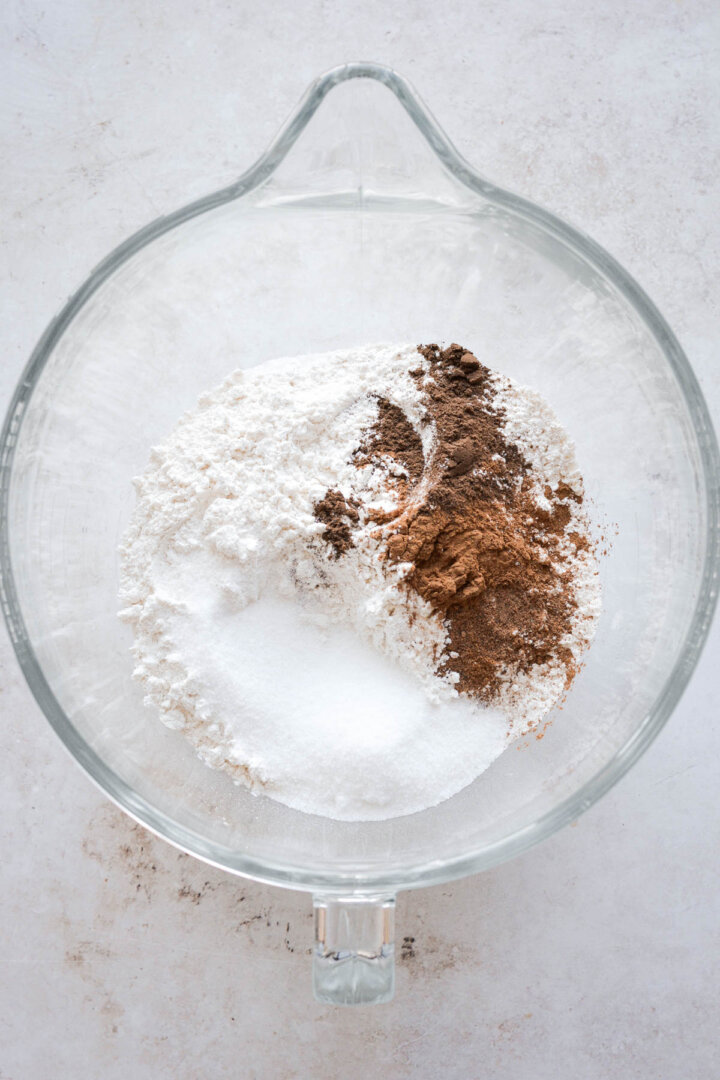

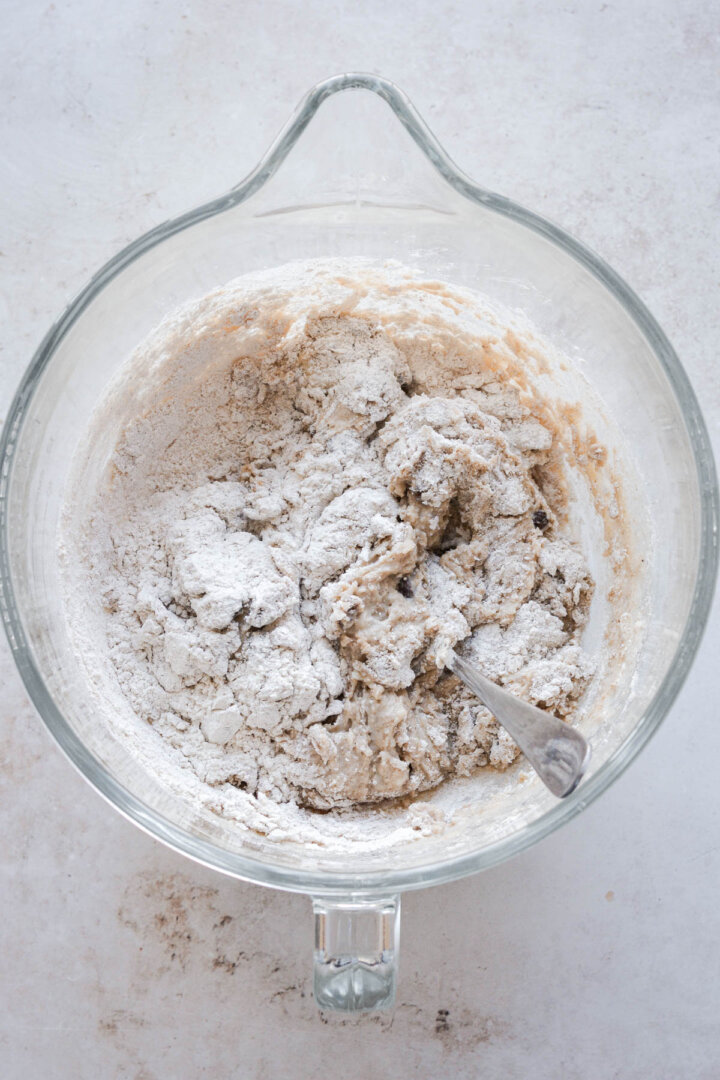

- Scrape the dough into a greased bowl. Cover tightly with plastic wrap, and set in a warm place to rise until doubled in size. This could take anywhere from 45-90 minutes, depending on the freshness/brand of yeast, and how warm your kitchen is.
- If your oven has a bread proof setting, you can use that. Otherwise, preheat your oven to the lowest setting, turn it off, then set the dough inside to rise.


Shape the Buns
- Turn the dough out onto a lightly floured surface, and flour the top of the dough, too. Gently press the dough out into a circle, about 1/2 inch thick. Cut the dough into 12 equal portions with a bench scraper or a sharp chef’s knife, dipped in flour in between cuts.
- Take a piece of dough, cup it in your hand, and pinch the dough together to form it into a bun, so that it’s smooth on top and pinched on the bottom.
- Place the buns, smooth side facing up, into a buttered 9×13 inch baking dish.
- Baker’s Note: If you want to make the dough and shape the buns the night before Easter, complete all the steps up to this point, cover the baking dish with plastic wrap, and refrigerate overnight. In the morning, proceed to the next step. The buns may need an hour or longer to come to room temperature and warm up before they start to puff and fill the pan. Once they do, they’re ready to bake.
- Cover the pan loosely with a clean kitchen towel, and set aside until the buns are starting to puff up, about 20-30 minutes.
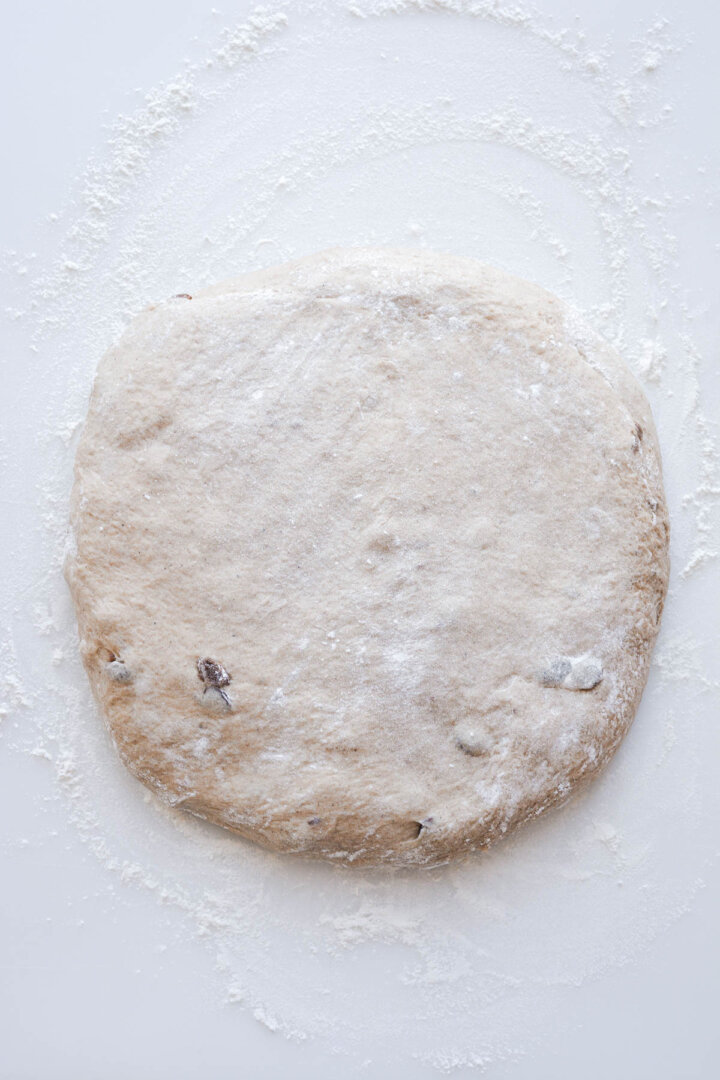

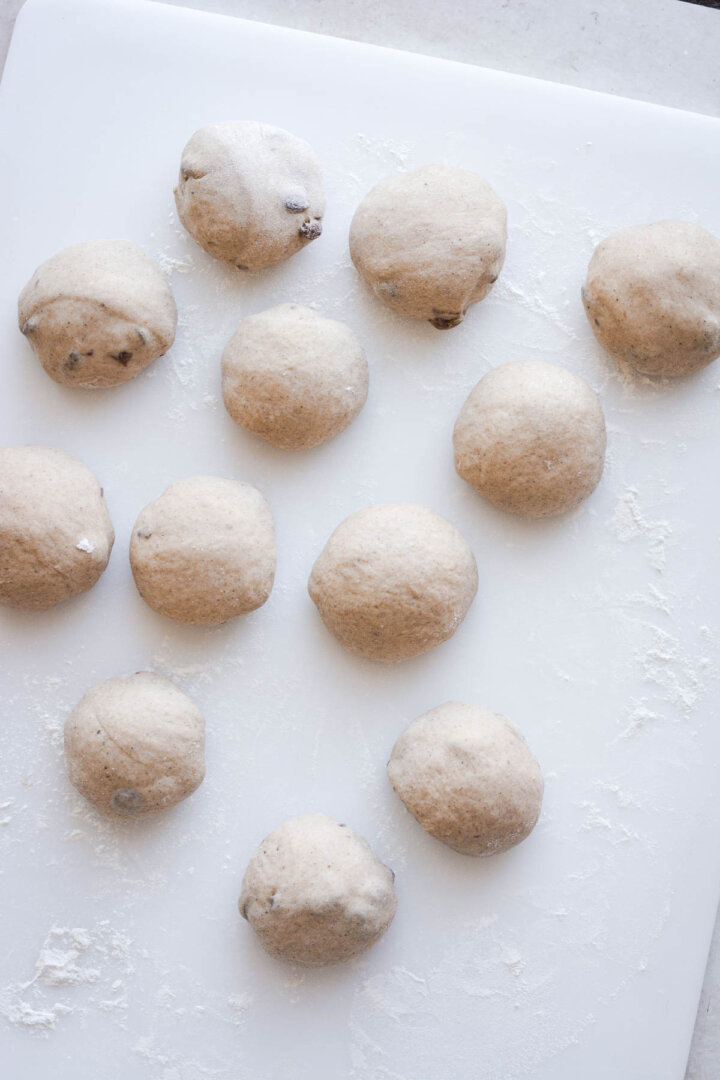
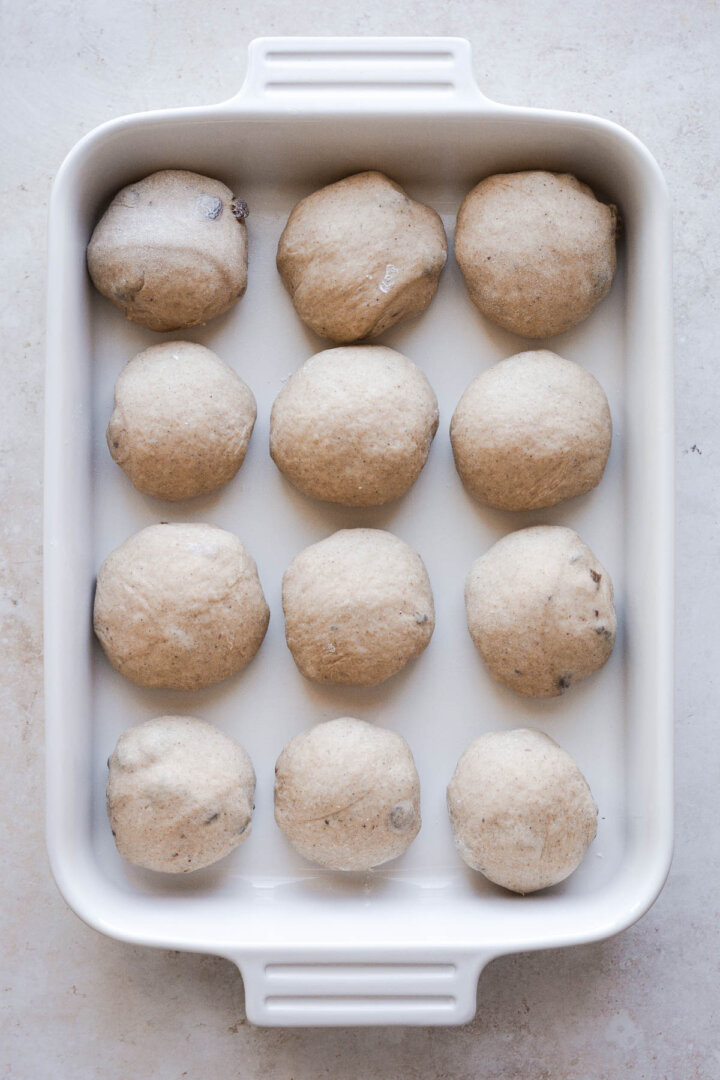
Bake
- Preheat the oven to 350 F, and position a rack in the center of the oven.
- For the egg wash, whisk together the egg and milk, and lightly brush the egg wash over the buns (save the leftover egg wash to add to scrambled eggs). This will give them a beautiful golden brown color as they bake.
- In another bowl, whisk together the flour and water to make a drizzly paste – it shouldn’t be so thick that you can’t pipe it through a piping bag, but you don’t want it too thin and watery, either. Scrape the flour paste into a piping bag, snip off the tip, and pipe the paste across the buns in both directions, to form a “cross” on each bun.


- Bake the buns for about 25-35 minutes, until golden brown on top and a digital instant read thermometer inserted into the buns reads 195 F. If the buns are underdone, they’ll have a doughy texture, but baking them for too long will dry them out, so checking the temperature is important for a perfectly baked bun.
- Brush the marmalade or jam over the top of the buns while they’re hot to give them a shiny finish and to add a little sweetness. Let cool for a few minutes, then pull the buns apart and serve warm with soft butter.

Be sure to read all of my BAKING FAQs where I discuss ingredients, substitutions and common baking questions, so that you can be successful in your own baking!
Frequently Asked Questions
Tangzhong or tang zhong is a simple roux or paste made of water, milk and flour. The tangzhong method is quick and easy. Just cook the ingredients in a saucepan for a minute or two until the mixture thickens into a paste. When this paste is added to yeast dough, it plays a very important role in improving the texture of the dough and the baked bread. It helps the starches in the flour absorb more liquid, which in turn makes the dough less sticky and easier to knead and shape into buns. It can help the bread rise higher and fluffier as it bakes. And the baked bread, rolls or buns will stay soft and fresh for longer.
If all-purpose flour is all you can get your hands on, you can use it. But bread flour has a higher percentage of protein, which makes for a chewier texture in yeast dough.
You can microwave them at 50% power for 30 seconds, or reheat them in the oven at 300 F for about 5-7 minutes.

You Might Also Like

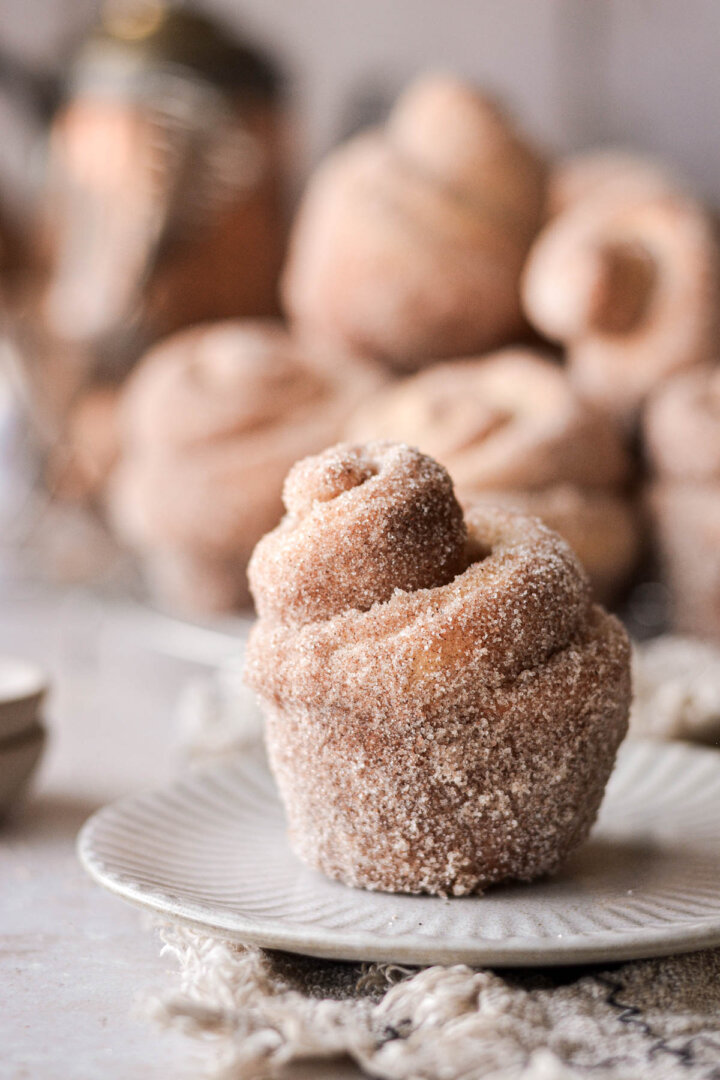

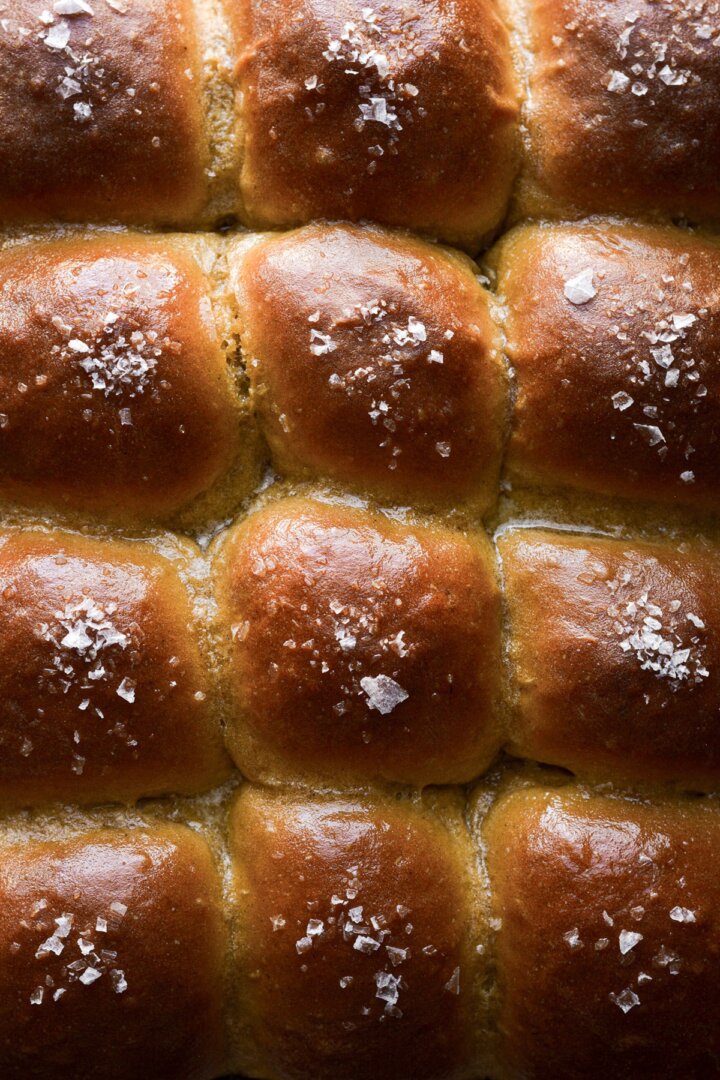
Please check out my Amazon Shop for a curated collection of some of my favorite cake pans from trusted brands, baking tools, ingredients, pretty things and fashion finds. I recommend products that I buy and use every day!
Did you love today’s recipe? Please rate the recipe and let me know in the comments what you thought! Also, be sure to follow Curly Girl Kitchen on Instagram, and tag me when you try one of my recipes so I can see all your delicious creations!

High Altitude Hot Cross Buns
All recipes on Curly Girl Kitchen are developed for high altitude at 5,280 feet. See FAQs for adjusting to higher or lower elevations.
Equipment
- Stand Mixer with Dough Hook
- 9×13 Baking Dish
Ingredients
Tangzhong
- 3 tbsp water
- 3 tbsp whole milk
- 2 tbsp bread flour
Dough
- ⅔ cup raisins
- ¼ cup hot water
- 4 tbsp unsalted butter
- ¾ cup whole milk
- 1 packet (2 1/4 tsp) active dry or instant/rapid rise yeast
- ¼ cup granulated sugar, divided
- 3 cups bread flour, fluffed, spooned and leveled
- 1 tsp coarse Kosher salt (if using table salt, use half the amount)
- 1 ½ tsp ground cinnamon
- 1 tsp ground allspice
- ½ tsp ground nutmeg
- 1 large egg, room temperature
Egg Wash and Cross
- 1 large egg
- 1 tbsp whole milk
- ¼ cup all-purpose flour
- 2-3 tbsp water
Glaze
- ½ cup orange marmalade or apricot jam, pureed and slightly warmed
Instructions
Make the Tangzhong
- In a small saucepan, whisk together the water, milk and flour. Cook over medium heat for several minutes, whisking constantly, until it thickens into a paste.
- Remove from the heat, scrape the tangzhong into a small bowl, and refrigerate to cool it down while you make the dough.
Make the Dough
- In a small bowl, combine the raisins with the hot water, then let them soak and soften for several minutes.
- In the same saucepan you used to make the tangzhong (no need to wash the pan first), melt the butter over medium heat. Stir in the milk, and warm the mixture just until it reaches between 110-115 degrees Fahrenheit.
- Remove from the heat. Stir in the yeast and 1 tablespoon of sugar. Let sit for a few minutes until it starts to get bubbly.
- In the bowl of your stand mixer, combine all but 1/2 cup of the flour with the remainder of the sugar, salt and spices. Add the warm yeast mixture, the cooled tangzhong, egg and raisins, including the raisin water.
- With the dough hook, knead the dough for 10 minutes, gradually adding the remaining 1/2 cup of flour, only if needed. The dough should be soft and smooth, and will wrap around the dough hook, but may still stick to the bottom of the bowl. Don't be tempted to add more flour, though, or the buns will be dense.
- Scrape the dough into a greased bowl. Cover tightly with plastic wrap, and set in a warm place to rise until doubled in size. This could take anywhere from 45-90 minutes, depending on the freshness/brand of yeast, and how warm your kitchen is.If your oven has a bread proof setting, you can use that. Otherwise, preheat your oven to the lowest setting, turn it off, then set the dough inside to rise.
Shape the Buns
- Turn the dough out onto a lightly floured surface, and flour the top of the dough, too. Gently press the dough out into a circle, about 1/2 inch thick. Cut the dough into 12 equal portions with a bench scraper or a sharp chef's knife, dipped in flour in between cuts.
- Take a piece of dough, cup it in your hand, and pinch the dough together to form it into a bun, so that it's smooth on top and pinched on the bottom.
- Place the buns, smooth side facing up, into a buttered 9×13 inch baking dish.Baker's Note: If you want to make the dough and shape the buns the night before Easter, complete all the steps up to this point, cover the baking dish with plastic wrap, and refrigerate overnight. In the morning, proceed to the next step. The buns may need an hour or longer to come to room temperature and warm up before they start to puff and fill the pan. Once they do, they're ready to bake.
- Cover the pan loosely with a clean kitchen towel, and set aside until the buns are starting to puff up, about 20-30 minutes.
Bake
- Preheat the oven to 350 F, and position a rack in the center of the oven.
- For the egg wash, whisk together the egg and milk, and lightly brush the egg wash over the buns (save the leftover egg wash to add to scrambled eggs). This will give them a beautiful golden brown color as they bake.
- In another bowl, whisk together the flour and water to make a drizzly paste – it shouldn't be so thick that you can't pipe it through a piping bag, but you don't want it too thin and watery, either. Scrape the flour paste into a piping bag, snip off the tip, and pipe the paste across the buns in both directions, to form a "cross" on each bun.
- Bake the buns for about 25-35 minutes, until golden brown on top and a digital instant read thermometer inserted into the buns reads 195 F. If the buns are underdone, they'll have a doughy texture, but baking them for too long will dry them out, so checking the temperature is important for a perfectly baked bun.
- Brush the marmalade or jam over the top of the buns while they're hot to give them a shiny finish and to add a little sweetness. Let cool for a few minutes, then pull the buns apart and serve warm with soft butter.

Do these freeze well? Would like to make several pans of them for Fellowship time after Easter church service but cannot make 6 dozen of them the day before.
Helen, yes, all of my rolls and buns freeze well – I often make them in advance of a holiday when I’m testing recipes, and then freeze some to eat on the holiday itself. I just wrap them in several layers of plastic wrap or in a ziplock bag. Then after thawing, I’ll warm them up in the microwave at 50% power just before serving, which makes them so soft again.
To make 6 dozen buns there are a few things you could do, though. If you’re using your stand mixer to make the dough, a 4-5 qt tilt head mixer will likely only accommodate a single batch of dough, but you could double the batch if you have a 7 qt lift stand mixer, and then you’d only have to make 3 double batches of dough instead of 6 single batches. Instead of baking 1 dozen at a time in a 9×13 baking pan, I’d probably bake 2 dozen at a time on a 13×18 rimmed baking sheet. If you have 3 baking sheets, and enough fridge space, you can shape the buns, arrange them on the baking sheets, cover with plastic, and refrigerate the pans overnight if you want to bake them all fresh the next morning.
I hope that helps!
These were nothing short of amazing! I followed the “make ahead” instructions exactly as written and I was so happy when they turned out beautifully! Baking at altitude is such a challenge and I am so happy to have found you and your recipes Heather! Thank you!